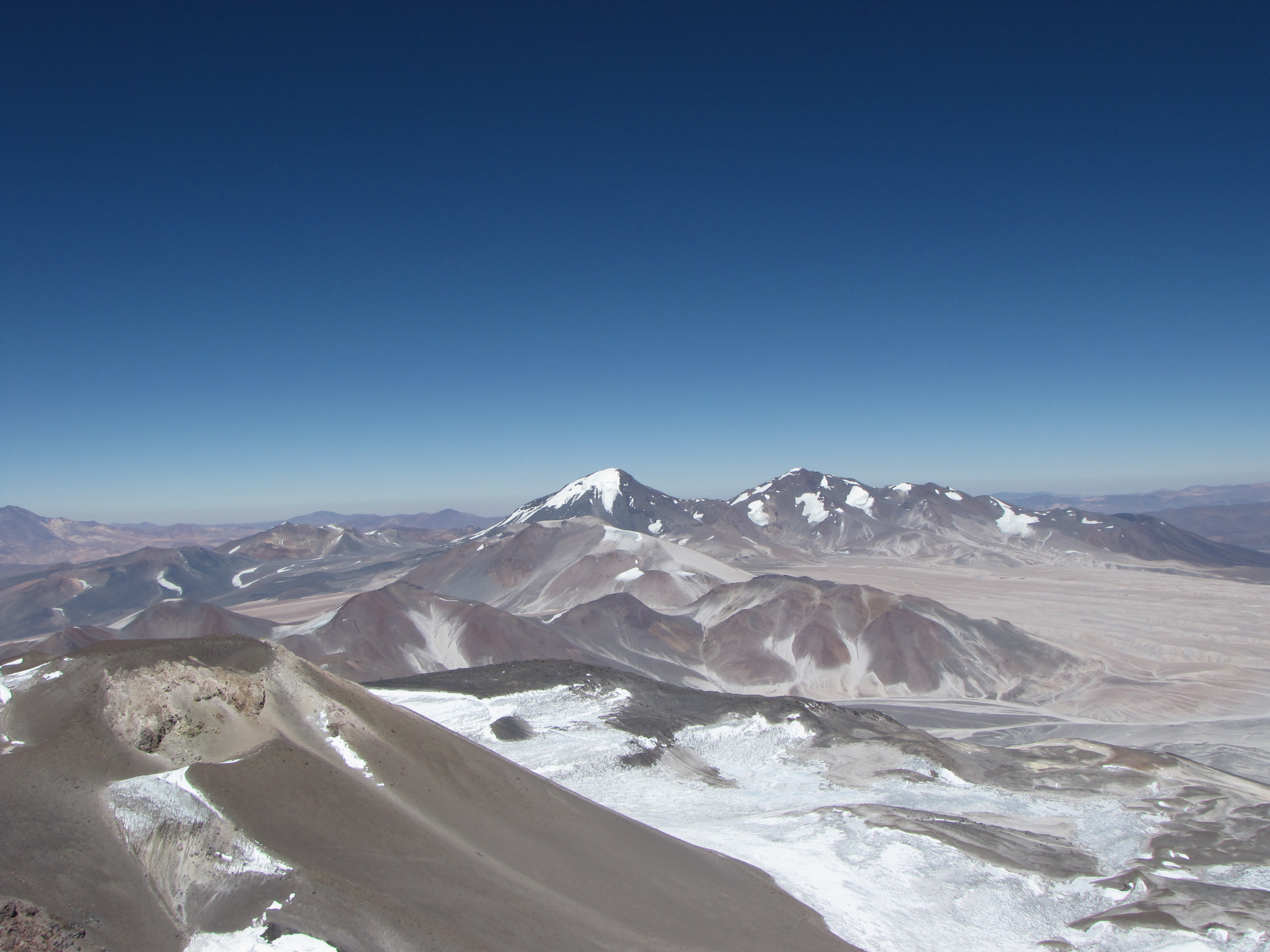|
Ojos Del Salado
Nevado Ojos del Salado is a dormant complex volcano in the Andes on the Argentina–Chile border. It is the highest volcano on Earth and the highest peak in Chile. The upper reaches of Ojos del Salado consist of several overlapping lava domes, lava flows and volcanic craters, with an only sparse ice cover. The complex extends over an area of and its highest summit reaches an altitude of above sea level. Numerous other volcanoes rise around Ojos del Salado. Due to its location near the Arid Diagonal of South America, the mountain has extremely dry conditions, which prevent the formation of glaciers and a permanent snow cover. Despite the arid climate, there is a permanent crater lake about in diameter at an elevation of - within the summit crater and east of the main summit. This is the highest lake of any kind in the world. Owing to its altitude and the desiccated climate, the mountain lacks vegetation. Ojos del Salado was volcanically active during the Pleistocene and Ho ... [...More Info...] [...Related Items...] OR: [Wikipedia] [Google] [Baidu] |
Volcanic Seven Summits
The Volcanic Seven Summits are the highest volcanoes on each of the seven continents, just as the Seven Summits are the highest peaks on each of the seven continents. Summiting all seven is regarded as a mountaineering challenge, first postulated as such in 1999. Two of the Volcanic Seven Summits are also in the Seven Summits list. Mount Kilimanjaro and Mount Elbrus, which were formed volcanically, are the highest peaks of their respective continents. Definitions Due to different interpretations of continental borders (geological, geographical, geopolitical) several definitions for the highest summits per continent and the number of continents are possible. The number of seven continents used here is based on the continent model used in Western Europe and the United States. An additional complication in determining the highest volcanic summits is defining exactly what constitutes a volcano and how much topographic prominence it must have relative to any nearby non-volcanic ... [...More Info...] [...Related Items...] OR: [Wikipedia] [Google] [Baidu] |
Snow Cover
Snow comprises individual ice crystals that grow while suspended in the atmosphere—usually within clouds—and then fall, accumulating on the ground where they undergo further changes. It consists of frozen crystalline water throughout its life cycle, starting when, under suitable conditions, the ice crystals form in the atmosphere, increase to millimeter size, precipitate and accumulate on surfaces, then metamorphose in place, and ultimately melt, slide or sublimate away. Snowstorms organize and develop by feeding on sources of atmospheric moisture and cold air. Snowflakes nucleate around particles in the atmosphere by attracting supercooled water droplets, which freeze in hexagonal-shaped crystals. Snowflakes take on a variety of shapes, basic among these are platelets, needles, columns and rime. As snow accumulates into a snowpack, it may blow into drifts. Over time, accumulated snow metamorphoses, by sintering, sublimation and freeze-thaw. Where the climate is c ... [...More Info...] [...Related Items...] OR: [Wikipedia] [Google] [Baidu] |
High Plateau
In geology and physical geography, a plateau (; ; ), also called a high plain or a tableland, is an area of a highland consisting of flat terrain that is raised sharply above the surrounding area on at least one side. Often one or more sides have deep hills or escarpments. Plateaus can be formed by a number of processes, including upwelling of volcanic magma, extrusion of lava, and erosion by water and glaciers. Plateaus are classified according to their surrounding environment as intermontane, piedmont, or continental. A few plateaus may have a small flat top while others have wide ones. Formation Plateaus can be formed by a number of processes, including upwelling of volcanic magma, extrusion of lava, Plate tectonics movements and erosion by water and glaciers. Volcanic Volcanic plateaus are produced by volcanic activity. The Columbia Plateau in the north-western United States is an example. They may be formed by upwelling of volcanic magma or extrusion of lava. The ... [...More Info...] [...Related Items...] OR: [Wikipedia] [Google] [Baidu] |
Puna De Atacama
The Puna de Atacama or Atacama Plateau article at the '''' website is an arid high , in the of northern (15%) and (85%). [...More Info...] [...Related Items...] OR: [Wikipedia] [Google] [Baidu] |
Cerro Solo
Cerro Solo is a large stratovolcano on the border between Argentina and Chile, west of Ojos del Salado with an elevation of metres. It consists of nine eruptive centers and is covered in light-colored rhyodacite pyroclastic flow deposits. Its territory is within the Argentinean protection area of Catamarca High Andean and Puna Lakes Ramsar Site. It is located in the territory of the Argentinean province of Catamarca (commune of Fiambalá) and the Chilean province of Copiapo (commune of Copiapó). First Ascent Solo was first climbed by Luis Alvarado, Jorge Balastino, Carlos and Oscar Alvarez (Chile) on 21 February 1950. See also * List of volcanoes in Argentina *List of volcanoes in Chile The Smithsonian Institution's Global Volcanism Program lists 105 volcanoes in Chile that have been active during the Holocene. [...More Info...] [...Related Items...] OR: [Wikipedia] [Google] [Baidu] |
Deutscher Alpenverein
The German Alpine Club (german: links=no, Deutscher Alpenverein, DAV for short) is the world's largest climbing association and the eighth-largest sporting association in Germany. It is a member of the German Olympic Sports Confederation and the competent body for sport and competition climbing, hiking, mountaineering, hill walking, ice climbing, mountain expeditions, as well as ski mountaineering. It is an association made up of local branches known as 'sections'. History The German Alpine Club was founded as on 9 May 1869 in Munich by 36 former members of the Austrian Alpine Club around the Ötztal curate Franz Senn. It was founded in order to promote the development of tourism in the Eastern Alps through the building of mountain huts, and establishment of hiking trails, and via ferratas. The association had a large membership from the beginning, attracting 1,070 members in the first ten months. The German and the Austrian societies merged in 1873 to form the German ... [...More Info...] [...Related Items...] OR: [Wikipedia] [Google] [Baidu] |
Aconcagua
Aconcagua () is a mountain in the Principal Cordillera of the Andes mountain range, in Mendoza Province, Argentina. It is the highest mountain in the Americas, the highest outside Asia, and the highest in the Southern Hemisphere with a summit elevation of . It lies northwest of the provincial capital, the city of Mendoza, about from San Juan Province, and from Argentina's border with neighbouring Chile. The mountain is one of the Seven Summits of the seven continents. Aconcagua is bounded by the ''Valle de las Vacas'' to the north and east and the ''Valle de los Horcones Inferior'' to the west and south. The mountain and its surroundings are part of the Aconcagua Provincial Park. The mountain has a number of glaciers. The largest glacier is the Ventisquero Horcones Inferior at about long, which descends from the south face to about in elevation near the Confluencia camp. Two other large glacier systems are the Ventisquero de las Vacas Sur and Glaciar Este/Ventisquer ... [...More Info...] [...Related Items...] OR: [Wikipedia] [Google] [Baidu] |
Poland
Poland, officially the Republic of Poland, , is a country in Central Europe. Poland is divided into Voivodeships of Poland, sixteen voivodeships and is the fifth most populous member state of the European Union (EU), with over 38 million people, and the List of European countries by area, seventh largest EU country, covering a combined area of . It extends from the Baltic Sea in the north to the Sudetes and Carpathian Mountains in the south, bordering seven countries. The territory is characterised by a varied landscape, diverse ecosystems, and Temperate climate, temperate transitional climate. The capital and List of cities and towns in Poland, largest city is Warsaw; other major cities include Kraków, Wrocław, Łódź, Poznań, and Gdańsk. Prehistory and protohistory of Poland, Humans have been present on Polish soil since the Lower Paleolithic, with continuous settlement since the end of the Last Glacial Period over 12,000 years ago. Culturally diverse throughout ... [...More Info...] [...Related Items...] OR: [Wikipedia] [Google] [Baidu] |
Jan Alfred Szczepański
Jan Alfred Szczepański (9 November 1902 in Kraków – 20 March 1991 in Warsaw Warsaw ( pl, Warszawa, ), officially the Capital City of Warsaw,, abbreviation: ''m.st. Warszawa'' is the capital and largest city of Poland. The metropolis stands on the River Vistula in east-central Poland, and its population is official ...) was a Polish journalist, theatre critic and mountaineer. 1902 births 1991 deaths Journalists from Kraków Polish mountain climbers Polish film critics Polish theatre critics Burials at Rakowicki Cemetery Jagiellonian University alumni {{Poland-journalist-stub ... [...More Info...] [...Related Items...] OR: [Wikipedia] [Google] [Baidu] |
Nevado Tres Cruces
Nevado Tres Cruces is a massif of volcanic origin in the Andes Mountains on the border of Argentina and Chile. It has two main summits, Tres Cruces Sur at and Tres Cruces Centro at and a third minor summit, Tres Cruces Norte . Tres Cruces Sur is the sixth highest mountain in the Andes. The volcano has an extended history of activity, going back at least 1.5 million years. A number of lava domes surround the complex and a number of craters lie on its summits. The main volcano is of rhyodacitic composition and has generated two major ignimbritic eruptions, one 1.5 million years ago and a second 67,000 years ago. The last eruption was 28,000 years ago, but the volcano is a candidate source for a Holocene eruption and could erupt again in the future. Geography and geomorphology Nevado Tres Cruces is located in the High Andes of Copiapo and straddles the boundary between Chile ( Atacama Region) and Argentina (Catamarca Province). The Salar de Maricunga is located west of Nevad ... [...More Info...] [...Related Items...] OR: [Wikipedia] [Google] [Baidu] |
Caldera
A caldera ( ) is a large cauldron-like hollow that forms shortly after the emptying of a magma chamber in a volcano eruption. When large volumes of magma are erupted over a short time, structural support for the rock above the magma chamber is gone. The ground surface then collapses into the emptied or partially emptied magma chamber, leaving a large depression at the surface (from one to dozens of kilometers in diameter). Although sometimes described as a crater, the feature is actually a type of sinkhole, as it is formed through subsidence and collapse rather than an explosion or impact. Compared to the thousands of volcanic eruptions that occur each century, the formation of a caldera is a rare event, occurring only a few times per century. Only seven caldera-forming collapses are known to have occurred between 1911 and 2016. More recently, a caldera collapse occurred at Kīlauea, Hawaii in 2018. Etymology The term ''caldera'' comes from Spanish ', and Latin ', mean ... [...More Info...] [...Related Items...] OR: [Wikipedia] [Google] [Baidu] |
Holocene
The Holocene ( ) is the current geological epoch. It began approximately 11,650 cal years Before Present (), after the Last Glacial Period, which concluded with the Holocene glacial retreat. The Holocene and the preceding Pleistocene together form the Quaternary period. The Holocene has been identified with the current warm period, known as MIS 1. It is considered by some to be an interglacial period within the Pleistocene Epoch, called the Flandrian interglacial.Oxford University Press – Why Geography Matters: More Than Ever (book) – "Holocene Humanity" section https://books.google.com/books?id=7P0_sWIcBNsC The Holocene corresponds with the rapid proliferation, growth and impacts of the human species worldwide, including all of its written history, technological revolutions, development of major civilizations, and overall significant transition towards urban living in the present. The human impact on modern-era Earth and its ecosystems may be considered of global ... [...More Info...] [...Related Items...] OR: [Wikipedia] [Google] [Baidu] |







